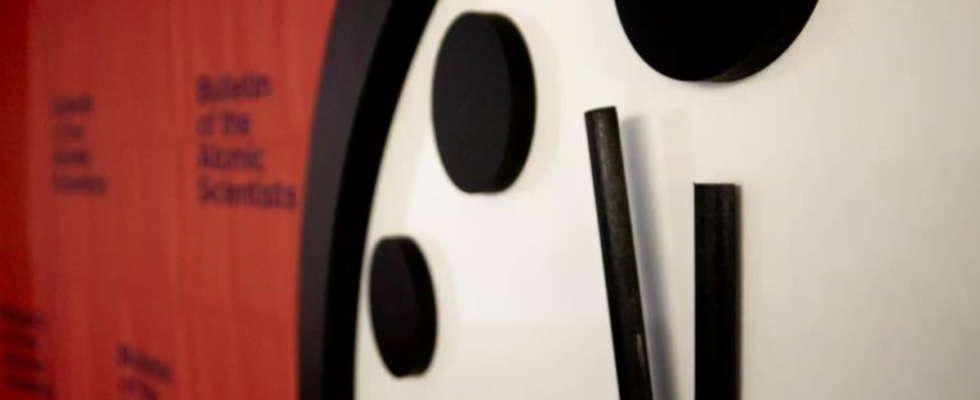published
First it was nuclear weapons, then climate change and pandemics, among other things, drove the hands of the so-called “doomsday clock” towards midnight. On Thursday the state of the clock will be announced for the 75th time.
On Thursday, scientists want to announce this year’s status of the “Doomsday Clock”.
The last time the hand was 100 seconds before midnight.
The coronavirus pandemic, as well as global warming and fake news, are serious human concerns.
The “doomsday clock” doesn’t tick and isn’t actually a real clock at all. The “Doomsday Clock” is a design originally created by the US artist Martyl Langsdorf, who died in 2013. In June 1947, Martyl Langsdorf, whose husband Alexander had worked on the development of the atomic bomb in the USA’s “Manhattan Project”, was supposed to design a cover for the “Bulletin of the Atomic Scientists”, the journal of the atomic scientists – and decided to do it the upper left quarter of a clock pointing seven minutes to midnight. “That looked good to my eye.”
Shortly after the devastating atomic bombs were dropped on the Japanese cities of Hiroshima and Nagasaki, Langsdorf and the publishers of the magazine wanted to use the cover photo to make it clear how great the danger posed by the new weapon technology was and how urgently it had to be brought under control.
Since then, scientists and editors of the Nuclear Scientists’ Bulletin have reassessed the position of the clock’s minute hand every year to show how endangered they think the survival of humanity is – in the face of nuclear weapons, but now also in the face of climate change and other threats. On Thursday (January 20), the scientists want to announce this year’s status, in the 75th anniversary year of the “Doomsday Clock”.
Midnight means end of the world
Most recently, they had assessed the dangers for humanity as so great that it was no longer possible to calculate in minutes. While in 2018 and 2019 the clock was still two minutes before midnight, in 2020 its hands were advanced to 100 seconds before midnight for the first time. The danger of mankind wiping itself out as a result of nuclear war or climate change is greater than at any time since the clock was invented. Midnight would mean the end of the world.
In addition to the possibility of nuclear war, the scientists now see the coronavirus pandemic, global warming and digital misinformation as particularly dangerous factors.
In 2007 the world was optimistic
Also in 2021 the hands were left at 100 seconds before midnight. “The pandemic has shown how unprepared and unwilling the world’s countries and the international system are when it comes to properly tackling global emergencies,” said Rachel Bronson, President of the Bulletin of Atomic Scientists.
But there have also been more optimistic times in the history of the “Doomsday Clock”, whose appearance was revised again in 2007 by graphic designer Michael Bierut and which has also been on display in a physical edition at the University of Chicago since 2019: At the end of the Cold War the clock stood at 17 minutes to the hour in 1991 – the furthest distance from midnight in the history of the «doomsday clock». “The illusion that tens of thousands of nuclear weapons are a guarantee of national security has been thrown overboard,” the Bulletin said with relief.
“Doomsday Clock” has no political agenda
Since then, however, the second hand has tended to move closer to midnight again – nuclear weapons tests in India and Pakistan, the unpredictability of US policy under ex-President Donald Trump, North Korean missile tests and the lack of disarmament negotiations all played their part.
The “doomsday clock” is not a scientific instrument, but a purely symbolic one. The publishers of the “Bulletin” emphasize that one sees oneself as doctors who make a diagnosis and has no partisan political agenda. The watch gets a lot of attention and support every year – but there is also skepticism and criticism. If you keep warning every year, does anyone even listen? – ask some critics.
“If I’m kind, I say, OK, they’re part of a broader effort to focus the collective attention on urgent issues or long-term issues that could have catastrophic effects, like climate change,” said Andrew Latham, a researcher at Macalester College in Minnesota of the “New York Times”. “But after a certain time, we will all stop listening.” Nevertheless, the clock has its meaning. “Once a year she reminds us that there are some big dangers out there. They are all man-made – and that means they can also be reversed by humans.”
As a member, you become part of the 20-minute community and benefit from great benefits and exclusive competitions every day!
(DPA/small)


